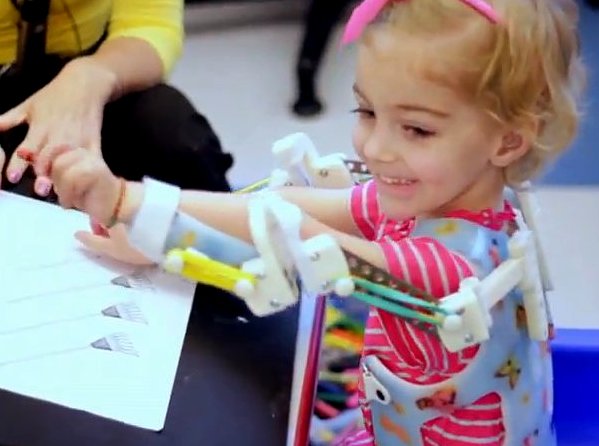3D Printing Is Disruptive Technology With Political Ramifications

 Emma and her 3D printed “magic arms” that give her full mobility Credit: Stratasys
Emma and her 3D printed “magic arms” that give her full mobility Credit: Stratasys
3D printing, the ability to print three-dimensional objects, is quickly becoming mainstream. This is classic disruptive technology, a new way of doing things that makes current technology obsolete. It will create new industries and eliminate old ones. The trend towards 3D printing cannot be stopped. And it absolutely has a political component, as it can route around government regulations and will undoubtedly make some patent and copyright holders go berserk in attempts to stop it.
3D printing works by the printer laying down one tiny layer at a time to create an object based on instructions given to the computer controlling the printer.
The following examples of 3D printing show the enormous range and startling things being printed and accomplished.
- NASA needs to be able to create tools in space. They took an adjustable wrench to a firm with a high tech 3D printer. The wrench is scanned, printed, and then infused with metal. The result is a completely operational wrench with movable parts, printed in one piece.
- Researchers believe they may be able to use 3D printing to create drugs that “could hold the key for easy and cheap drug distribution.” Drugs would not have to be shipped but rather created on the spot as needed.
- Two year old Emma was born with a condition that limits use of her arms. Traditional exoskeletons were too heavy. She now has a 3D printed exoskeleton that she calls her “magic arms.” Even better, new parts can simply be printed when she outgrows them or a part fails.
- Bioengineers are 3D printing blood vessel networks for use in lab-grown organs created from a patient’s own cells.
- Guns are being 3D printed and are completely operational. Many more weapons will be printed soon enough. Also, converting a semi-auto AR-15 into a full-auto can be done now by printing the part. Technology has thus routed itself around what used to be difficult or impossible to do.
Some say 3D printing will be “bigger than the Internet” and this is probably true. Transportation, parts manufacturers, and a host of other industries will need to adapt, and quickly. Maybe one day auto parts stores will simply be able to print many of the parts you need. This of course leads into the realms of copyrights and patents. How can a manufacturer of an object protect their patents if the object can scanned then printed? What will governments think about the very real possibility of insurgents or terrorists printing special weapons designed for specific situations?
Think: global file sharing of designs for serviceable weapons, from pistols on up that can be printed at home. What you can print -- from the materials to the size/quality of the object to the completeness (snap together construction) -- is already moving forward quickly. The weapons effort will just be along for the ride.
Disruptive technologies like 3D printing are indeed disruptive, as well as unstoppable.


